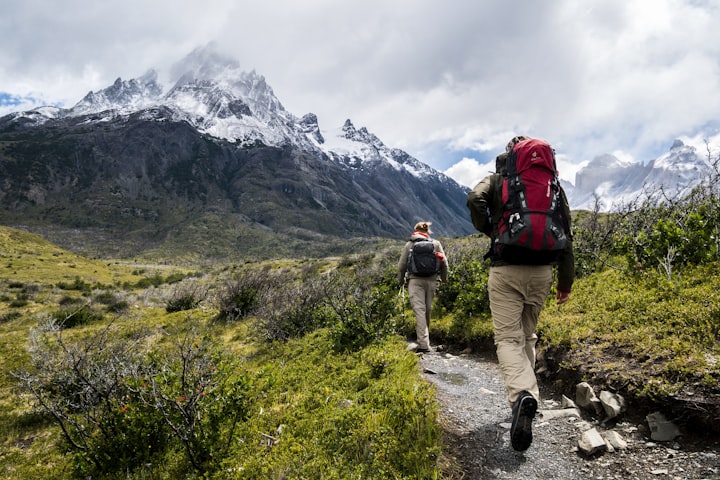
Experienced hikers know that a successful trip is largely down to preparation. Knowing what to pack and how to pack it makes all the difference. The following hiking guide for beginners will help you plan for a memorable hike.
When drawing up your packing list, there are ten essentials that every hiker should include:
1. Water or water-purifying kit 2. food 3. map 4. compass 5. matches or fire starting kit 6. multipurpose penknife 7. clothing 8. wet weather gear 9. torch 10. first aid kit
These are the survival items without which you'd find it difficult to get by. Failing to carry any of these would leave you open to injury should the worst happen. Assuming that everything goes well, there are a few obvious omissions to this kit list that you'd usually want to take:
1. tent 2. sleeping bag 3. gas stove or spirit burner 4. cooking utensils 5. mug 6. bowl 7. hat 8. sunglasses 9. sunscreen 10. travel towel
Combine these two lists and you have every you could need, whether you're planning a weekend hike or a longer trip. If you still have room in your pack after all this, below a few items you might include to the comfort and enjoyment of your trip:
1. water bottle 2. small thermos flask 3. self-inflating roll mat 4. sleeping bag liner 5. plate or receptacle for food preparation 6. soap (phosphate-free) 7. biodegradable detergent (phosphate-free) 8. notepad and pen 9. book 10. pocket camera
Of the items listed, food and clothing are among the most important. They're also the areas where good choices can make all the difference.
Food guide: Wet food can be heavy and takes up more space in your pack. Dried food is preferable. Instant noodles, oats, soups, milk, eggs, potatoes all in powered form are useful and filling. Complete nutritionally-balanced meals are also available from specialist camping shops.
Take dried fruit such as apricots, apple slices, dates. If you do carry fresh fruit, choose pieces that will not be crushed easily and make a mess inside your pack. Apples or oranges are good.
Nuts and seeds are a valuable source of protein. Of particular nutritional value are almonds, macadamias, brazil nuts, sunflower seeds and pumpkin seeds.
I'd recommend that you always take a concentrated sugar source for an instant energy burst. Mint cake is the best, although chocolate is a good substitute. To drink, tea and coffee are ideal.
Clothing guide: Choosing what to wear on a hike is essential to comfort and health. Always choose clothes that are breathable, protect you from the elements and are quick-drying. You'll also want to layer your clothing. Rather than a few thick layers, choose several lighter layers. A base layer, insulating layer, thermal layer and outer layer as suits your environment and the ambient temperature.
Materials are also of vital importance. Base and mid-layers should be made of lightweight polyester or polypropylene. Manmade fibres are highly breathable and wick perspiration away from the skin, moving it to the outer layers and keeping you dry and comfortable. A microfleece makes the ideal thermal layer. Outer layers should be breathable and both water and wind resistant.
Wind chill can severely drain energy by causing the body to work hard to keep warm. In case of heavy rain it is also worth having a rain jacket and trousers. These are specially designed to keep rain out without causing you to overheat. Lastly it pays to wear two pairs of socks, one thin polyester pair underneath a thicker hiking sock. This can prevent sores and blisters. Hats can be overlooked but whether the sun is beating down or it's the middle of winter, wearing a hat can keep you cool or cosy.
Packing tips: Always pack light items at the bottom of your backpack and heavy items at the top. This gives you better balance when wearing the pack and more support to your back. Your hike will be far more enjoyable if you follow this simple packing rule. Inexperienced hikers will often pack according to which items are likely to be used more or less. Pack instead for best space usage and comfort.
Pack items that you will need to reach quickly and frequently in the outer pockets and compartments. This might include water bottle Your tent and sleeping should be placed in waterproof drysacks and can be fastened to the outside of the backpack.
If you have a spirit burner, pack the fuel upright and ensure the container is correctly closed. For shorter hikes, gas stoves are probably better. Be mindful to keep fuel container away from your fire starting kit, utensils or other sharp objects.
The final word in this hiking guide of essentials must be: never overpack. Stick to your packing list and always use weight as a final check.






Comments
There are no comments for this story
Be the first to respond and start the conversation.